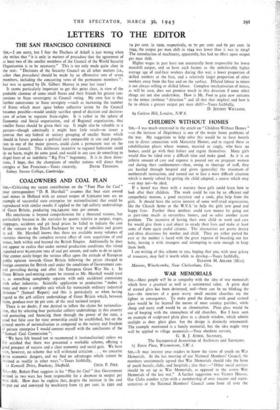COALOWNERS AND COAL PLAN
SIR,-.-Criticising my recent contribution on the "Foot Plan for Coal" your correspondent "D. B. Marshall" assumes that four state owned coal mines in Holland with an annual output of 8,500,000 tons are an example of successful state enterprise (or nationalisation) that could be reproduced with similar results if applied to the 746 colliery undertakings of Great Britain, producing 194,549,000 tons per annum.
His conclusion is beyond comprehension for a thousand reasons, but particularly because in the statistics he quotes relative to output, wages, stoppages, accidents and pit head prices he failed to indicate the cost of the venture to the Dutch Exchequer by way of subsidies and grants in aid. Mr. Marshall knows that there are available many volumes of statistics showing the complete reverse effect of state acquisition of coal mines, both within and beyond the British Empire. Additionally he does not appear to realise that under normal production conditions this island exported over 6o,000,00o tons of coal per annum, and seeks to do so again. Orie cannot easily forget the serious effect upon the attitude of European public opinion towards Great Britain following the prices charged to foreign countries for British coal under the conditions of Government con- trol prevailing during and after the European Great War No. 1. In Great Britain coal-mining cannot be treated as Mr. Marshall would treat it, as something completely separate with only accidental connexions with other industries. Scientific application to production "makes it more and more a complex unit which far transcends ordinary industrial divisions" (Samuel Report) and this is particularly so when having regard to the 416 colliery undertakings of Great Britain which, between them, produce over 99 per cent. of the total national output.
There is no doubt, if one desired to inflate the claims for nationalisa- tion, that by selecting four particular colliery undertakings in this country and protecting and fmancint them through the power of the state, a good but false case for state ownership could be established, but on the general merits of nationalisation as compared to the variety and freedom of private enterprise' I would'content myself with the conclusions of the "Samuel Coal Commission": "We have felt bound not to recommend it (nationalisation) unless we felt satisfied that there was presented a workable scheme, offering a good prospect of success and a clear economic and social gain. We have seen, however, no scheme that will withstand criticism . . . we conceive grave economic dangers, and we find no advantages which cannot be attained as readily in other ways."—Yours faithfully,
11 Kenwell Drive, Bradway, Sheffield. CECIL F. PIKE.
Sta,—Mr. Robert Foot suggests in his "Plan for Coal" that Government control in two wars has been responsible for a decrease in output per man shift. How does he explain that, despite the increase in the coal output cut and conveyed by machinery from 13 per cent. in 1920 and 14 per cent. in 1929, respectively, to 70 per cent. and 69 per cent. in 1944, the output per man shift in 1944 was lower than it was in 1914? The introduction of machinery, apparently, has had no effect upon output per man shift.
Higher wages in part have not unnaturally been responsible for lower manshift output, and so have such factors as the unbelievably higher average age of coal-face workers during this war, a lower proportion of skilled workers at the face, and a relatively larger proportion of other workers away from the face and on the surface. Diluted labour in mines is not always willing or skilled labour. Complete mechanisation of mines, as will be seen, does not promise much in this direction if some other things are not also undertaken. How is Mr. Foot to gain new entrants to the mines (without " direction " and all that that implies) and how is he to obtain a greater output per man shift?—Yours faithfully,






















 Previous page
Previous page